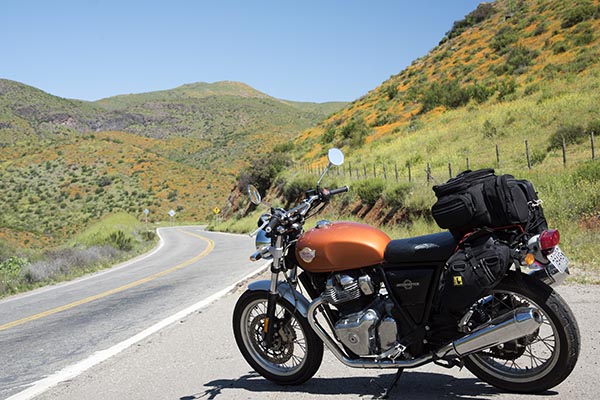
When I was a teenager and LBJ was in the White House, my standard against which all motorcycles were judged was the 1965 Triumph Bonneville. To me, that represented the ultimate motorcycle, and to this day, it’s what I think of when people start talking about the perfect motorcycle. It’s what came to mind when Royal Enfield announced the 650 Interceptor. I think 650 cubic centimeters is a good size for a motorcycle. I think a British vertical twin is the perfect vehicle (to borrow a phrase from good buddy Melissa Pierson). And I know that Baja is the best place on the planet for a motorcycle trip. That’s why I wanted to get the new Enfield and ride it through Baja. The perfect bike on the perfect ride. I predicted it would be a great trip. I was right.
Originally, we wanted to get two Interceptors, but they weren’t available. Enfield countered with an offer of two 500cc singles. Okay, we thought, that would do, and we realized it was a gutsy move on Enfield’s part to lend the bikes to us. Then that same dealer we’ve been so disappointed in couldn’t seem to get around to getting the bikes ready for us, and the plan shifted to an Interceptor and a Bullet. Even better, thought Gresh and I, and we were off, headed south into Baja. The two different bikes would make for an interesting contrast.
It’s a funny thing; we thought the story would focus primarily on the newer bike (the Interceptor), but the Bullet proved to be a fun and interesting motorcycle (like Gresh mentioned in his blog below). Don’t get me wrong; the Interceptor is an amazing machine. In fact, I’d say it was perfect. But it was almost too good (and I’ll get to that further along in this post).
Back in the day when I was a youngster dreaming about owning a Triumph Bonneville, I only knew one guy who rode an original Royal Enfield twin. That was Ricky Stang, a guy I knew in high school (go Vikings). Everyone else who rode was either on a Triumph or a Honda. Ricky had this amazing Enfield 750 with an all-chrome gas tank. He was (and still is) a cool guy. How cool, you might wonder? Well, he bought a Mustang car and modified the emblems by chopping off the M and the U, so his car said STANG (Ricky’s last name). That’s how we rolled back in the ‘60s.
Okay, back to the main attraction: The 2019 Royal Enfield Interceptor. Let’s start with the basics. It’s a 650cc vertical twin, just like my dream bike, the ’65 Triumph Bonneville. The Enfield brochure (downloadable on the Internet) puts the “kerb” weight at 202 kg (that’s 445 lbs; the ’65 Bonneville was 363 lbs), the wheelbase at 1400mm (that’s 55 inches, just like the ’65 Bonneville), and the horsepower at 47 (the ’65 Bonneville had 50). The new Enfield has a 6-speed transmission (the ’65 Bonneville had a 4-speed). Hmm, the right displacement and the right dimensions. The Enfield weighed a bit more, but the ’65 Bonneville didn’t have disk brakes front and rear, ABS, electric start, turn signals, an oil cooler, or catalytic converters.
The Enfield engine is magnificent. It is very torquey, and on our Baja foray I never felt like I was undergunned. The exhaust note is perfect (it sounds like a real motorcycle). The engine is extremely smooth. It didn’t seem to care what gear I was in; I could just roll on the throttle and the bike responded. In fact, a lot of times I’d be riding along thinking I was in 6th gear only to discover that the bike was in 5th or even 4th. It is that smooth. And a lot of times while climbing mountains in Baja’s Valle de los Cirios, I didn’t have to bother downshifting. Twist and go. Cool. We had the bike weighed down with lots of gear on our Baja trip; the Enfield didn’t seem to care. The engine is a 4-valve per cylinder, single overhead cam design, but the Enfield folks somehow managed to pull off the styling such that it looks a lot like the original overhead valve Enfield design of the 1960s (kudos for that). It is a good-looking and brilliantly-performing motor.
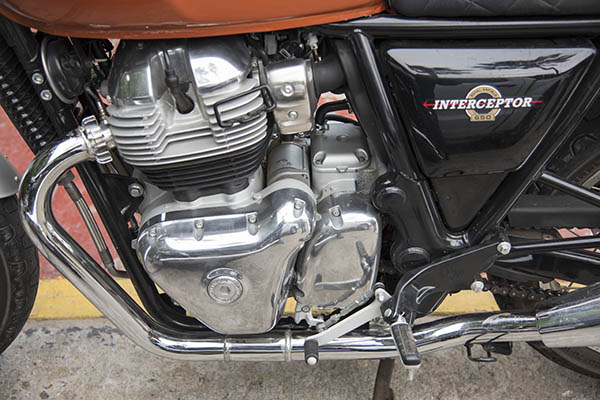
The bike never felt heavy to me. The Enfield carries its weight low and it felt light and quick everywhere. Yeah, on paper it’s 80 lbs heavier than the ’65 Bonneville. It didn’t feel like it, though. It feels good.
Enfield’s spec sheet says the bike is air-and-oil cooled, and there’s a non-obtrusive oil cooler mounted on the frame downtubes. The engine looks perfect. It’s nicely finned and you can see the thing. The exhaust system is a work of art. The mufflers are nicely shaped megaphones and brilliantly plated, and the exhaust header curvature is perfect. (Why is the word “perfect” emerging so frequently in this report?) I’m guessing the headers are a “pipe in a pipe” arrangement, as the pipes exhibited no heat discoloration. The clamps securing the exhaust headers to the cylinder head are neatly finned gizmos, just like Triumph had in the ’60s. Both sides of the engine have beautiful cases. Gresh commented that the engine’s left side cases were fashioned to make it look like the bike had separate engine and transmission cases, as Enfield had in days of yore. The Enfield guys got it right. I am impressed.
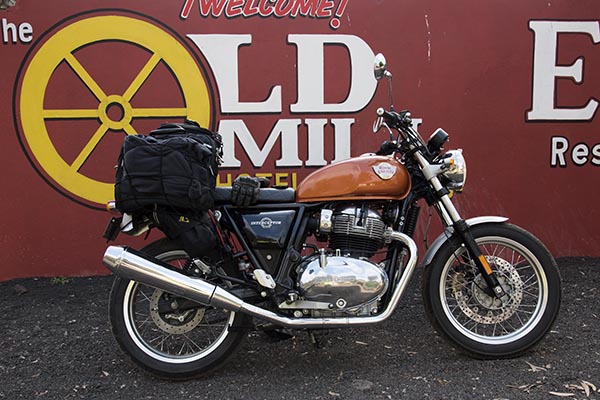
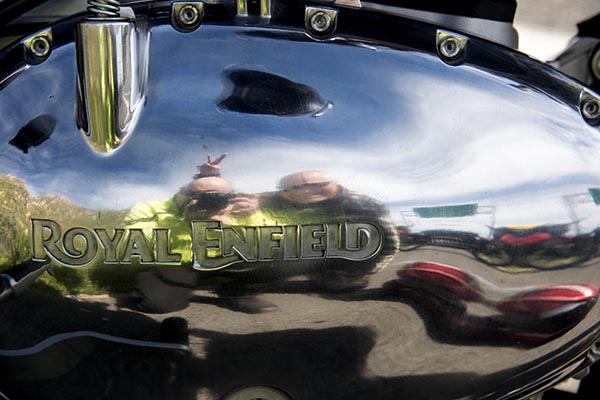
Gresh mentioned in an earlier blog that he reached 115 mph in 5th gear and 110 mph in 6th, confirming that 6th is really an overdrive. I never took the bike over 80; it would do it, I just didn’t want to. I found the bike stable at any speed. Fuel economy is outstanding. When we took delivery of the bike, it had 847 miles on the odometer and Joe measured 60 mpg on the first tank. On our last tank, with another 1300 miles on the bike, it returned 70 mpg. It never used any oil on our trip.
The headlight is a big chrome affair, just like Triumph (and basically all the British manufacturers) used to do. The beam was good, too. It lit up the street nicely.
The bike has a single disk in front and another in the rear. Both are ABS equipped. There’s no provision that we could see to turn the ABS off. Joe slammed the rear brake on a dirt road, and you could see where the ABS activated on and off in the bike’s track. The brakes are good. I never used them hard enough to activate the ABS feature, and that was okay by me.
The fuel tank is nicely contoured with a teardrop shape (it looks like a motorcycle gas tank should). Fuel capacity is 13.7 liters (that converts to 3.6 gallons). The tank emblems are gorgeous, although there was a very slight curvature mismatch where the leading edge of the emblem interfaced with the tank. That’s my inner motojournalist kicking in. I had to find something negative to say about the bike, and folks, this is one of very few nits I had with the bike. Yeah, I’m being picky. The gas cap is of the locking variety (it unlocks with the ignition key), and the cap is not hinged on the tank. You take it completely off when refilling. The bike ran equally well on regular or premium, and we mostly ran on regular because that’s all we could get once we went further into Baja.

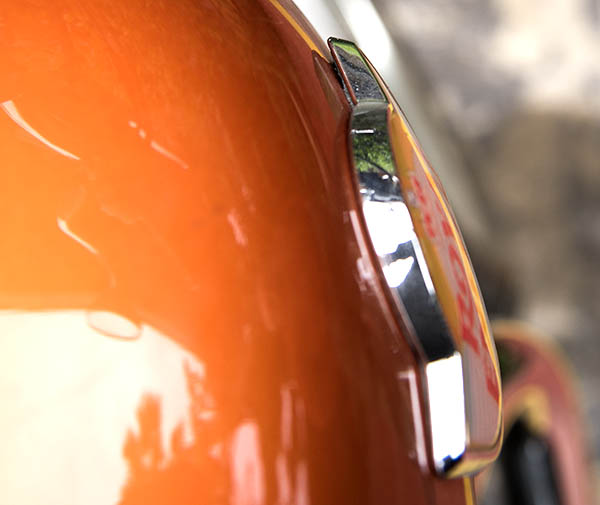
Here’s another nit: Joe and I both felt the left side of the bike is crowded around the footpeg. The gearshift is a little too close (I guess it could be adjusted upward, and I’d like the lever to be a little longer). The extensions for the kickstand and the centerstand extend far enough outside the bike and they are close enough to the footpeg that putting your foot down is a bit challenging. I didn’t like that all of that stuff (the gearshift, the footpeg, the kickstand extension, and the centerstand extension) stuck as far out as they did, and I had to think about where I put my foot down more than I do on other motorcycles. On the plus side, shifting was slick and effortless, there was no clunking, and the bike almost changed gears telepathically (it was that smooth). Getting the kickstand down was easy with the long extension, and pulling the bike up on the centerstand was also easy. Enfield provides a nice handhold on the left side of the bike for that purpose.
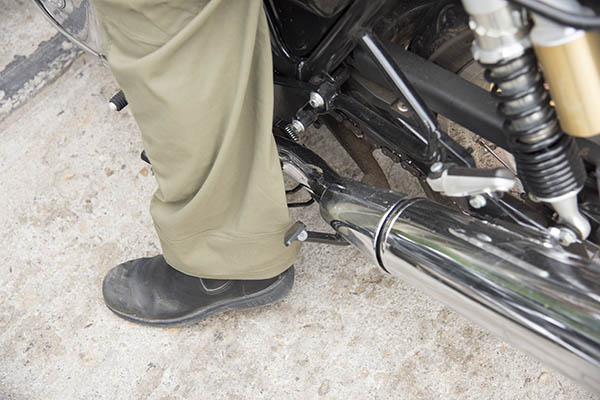
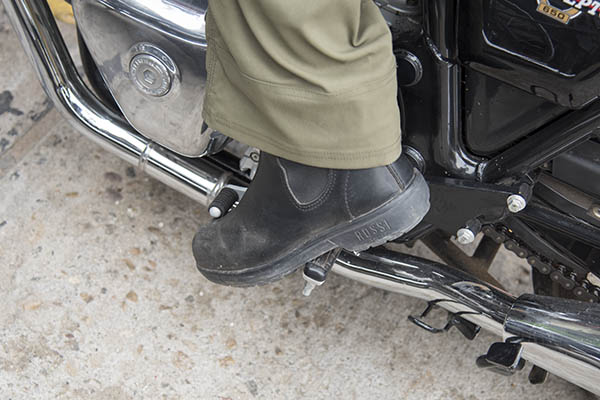
I’d call the instrumentation perfect (ah, there’s that word again). As I mentioned in one of the first blogs we did on the Interceptor, Enfield captured the essence of the big old Smiths instruments that used to adorn British bikes back in the ’60s. The bike has a digital, bar-based fuel gage in the left pod, an analog speedo and tach, high beam and turn signal indicators, an ABS light, and an odometer and two tripmeters. Stated differently, it has all the good stuff you need and none of the stuff you don’t. The tripmeter reset was a pushbutton between the speedo and tach. I found the tripmeter reset a little hard to actuate, but I haven’t been hitting the gym lately.

The horn on this bike is loud. It sounds like a European automobile horn. I liked that.
On the bodywork, everything looks great. The tank, as mentioned above, is is nicely shaped and the metalflake tangerine color is stunning. The Interceptor’s fenders are nicely shaped, a bit abbreviated (which I like), silver in color, and plastic, all of which is fine by me. The bike has a deep gloss black tubular double downtube frame, and that answers the mail nicely for a refined and classic Britbike look. The seat is long, not overly cushy, flat, and comfortable (it has a cable-actuated release accessible under the right body panel). The side covers work, too. I like that they are black. It fits the overall look nicely.
The handlebar switchgear is the same as the Bullet, which is the same as the CSC motorcycles, which is the same as 90% of the motorcycles sold today. Somewhere, there’s a single factory making handlebar switchgear for everyone. My guess is that factory has a Chongqing zip code. It all works nicely. The turn signals are not self-cancelling. The clutch and front brake levers (forgive me, Joe Gresh) fell easily to hand and were light to operate. One more minor nit: Joe noticed that the front brake left was shaped such that it had a minor drag against the right handlebar switchgear housing, and that this slight drag prevented the brake lever from returning all the way to the forward position (you could touch the front brake lever with your fingers to make it go all the forward). We probably could have adjusted that interference out by repositioning the front brake lever on the handlebar, but we did not. It’s a nit that will almost certainly be gone when the bikes go into production for the US market. Joe liked the handlebar crossbar; I thought it was the only thing on the bike that looked cheap. I think it would have been better if it was an integral part of the handlebar, as Janus does on their Gryffin model and CSC does on the TT250.
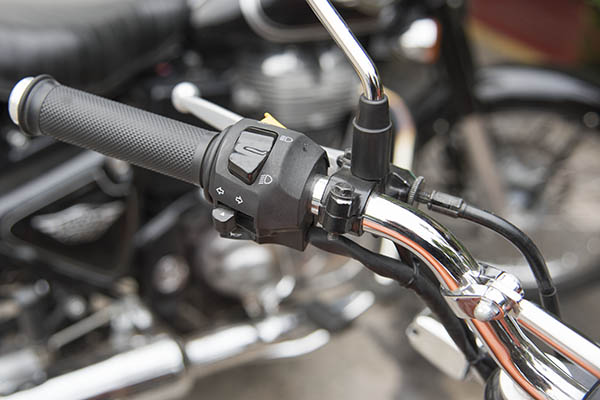
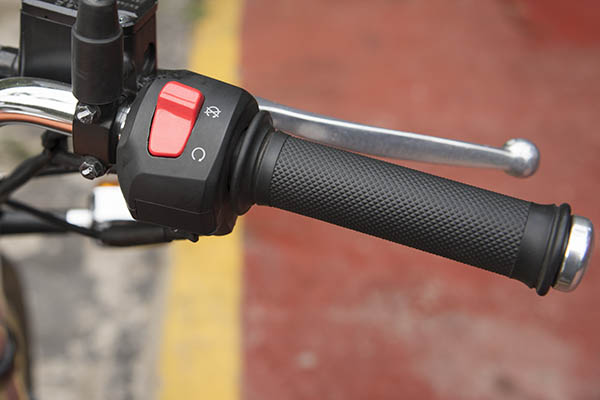

The front suspension is not adjustable, and if you have been following the ExNotes Enfield Baja blog, you know that’s okay by me. The rear suspension is adjustable for preload. As delivered to us, the rear shocks were set to a medium position. Our bike, being a preproduction prototype, did not have a tool kit, so there was no spanner to make any rear shock adjustments. You can see from some of our photos that we had the Interceptor loaded heavily with our gear and soft luggage, and I managed to bottom out the rear suspension a couple of times. No big deal. Suspension travel is about what’s needed on a street bike. The wheels are 18-inchers front and rear.
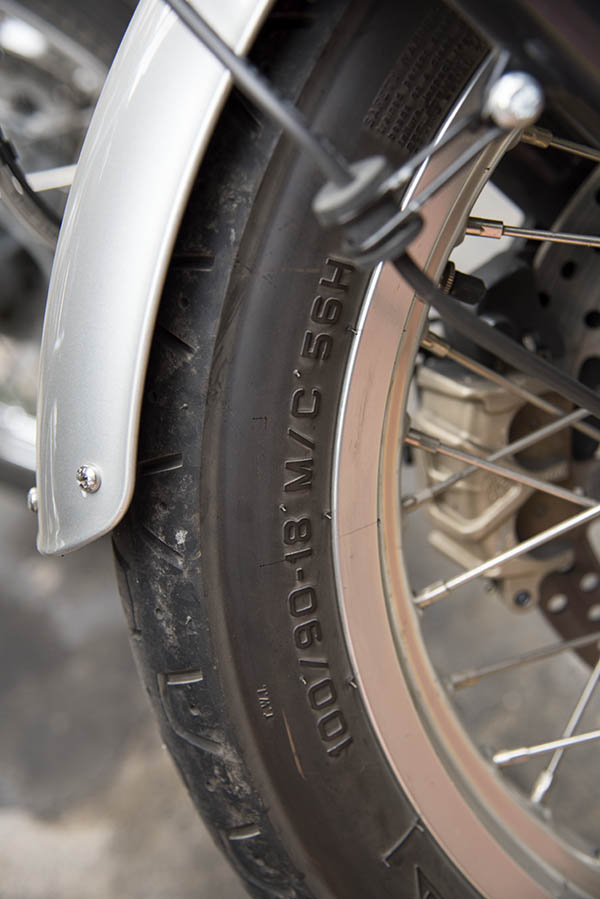
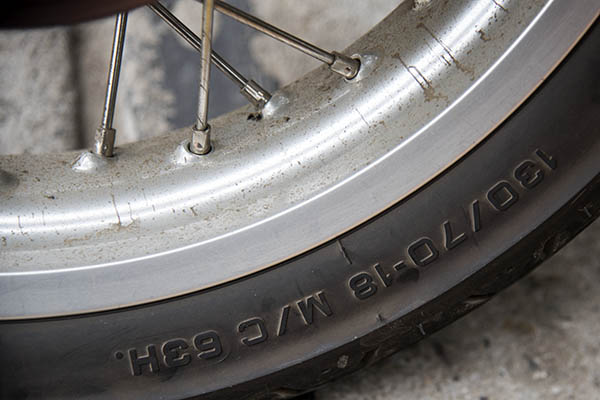
Our Enfield benefactor told us that officially the bike is to be known as the 650 INT, as the Interceptor name had some issues. I’m guessing that’s because a certain other motorcycle uses that name today (hint: that motorcycle is usually red). Ah, whatever. It seems to me that Enfield of yore (in the UK Enfield days) used the Interceptor name long before you met those nicest people on a…well, you know. And then, of course, there was the Ford Interceptor, the name the Blue Oval guys stuck on their police cruisers. So I thought I might help Enfield by suggesting a few other names. My first idea was that maybe they could call this bike the Kool Long Range 650 to honor our 1300-mile Baja adventure and the bike’s displacement, but that would abbreviate to KLR 650, and…well, you know. Another idea was that because the bike has electric starting and it is such a smooth ride, we could call it the Electra-Glide, but…well, you know. And then, because it is so well balanced and tractable with its torquey motor, we might call it the Go Slow, but that becomes GS, and I think someone is already using those initials. The tank badges are kind of gold in color and shaped like a wing, so maybe Gold Wing would work (is that already taken?). Maybe, because of where the bike is manufactured, we could just call it the Indian. What’s that? That name is already taken, too? It’s tough, I guess, naming a new bike.
Overall, I am extremely impressed with the new Royal Enfield 650 Interceptor. So much so, that I’m going to buy one if (as I mentioned in an earlier blog) I can convince the dealer that I’m not stupid and I’m not subsidizing their freight and setup fantasies. At first blush, one of the dealers told me freight and setup on this bike would be $1200. Uh huh. Look, I know that you can ship a bike anywhere in the lower 48 states for something around $350 (and that’s a max number; if you’re shipping it to a closer state it’s a lot less, and if you’re shipping several, the rates drop even more). Setup on this bike probably involves installing the mirrors, maybe the handlebars, and the front wheel, and all that should take under an hour. I don’t know why the dealers persist in this gouge-the-customer-for-freight-and-setup larceny. Well, I take that back. I do know. I just don’t like it, and I won’t pay it. A realistic freight and setup cost (to the dealer) is most likely below $350, and with a reasonable profit that number would go a little higher. But not $1200. No way, no how.
Okay, off the soapbox and back to the bike. I think the Enfield 650 is one of the best motorcycles I’ve ever ridden. It’s light, it’s smooth, it’s fast, it handles well, it gets good fuel economy, and the fit and finish are world class. It’s almost too good, in that maybe it doesn’t have the character or personality of the Bullet, or a 1965 Triumph Bonneville. But that’s a trade I’d make. Enfield hit a home run with the Interceptor. I think it’s perfect.

Joe, before you buy an Enfield 650 there is another bike you should check out and test ride: Moto Guzzi V7III. It has all the good things you said about the Enfield – classic styling, great seating position, low end torque, adequate power, good handling, reasonable weight. It is the best bike, for me, that I have owned. And if you do your own service; the valves are easy to get to and are screw & locknut, and the bike is shaft drive – no chain to deal with. Yes, it costs a bit more, but I think it is worth it. Take one for a test ride up Glendora Canyon, you will like it.
Thanks, Dan. Ah, so many bikes, so many great roads and destinations, so little time! I will find a local Guzzi dealer and check it out; thanks again for the tip. I always wanted a Guzzi.